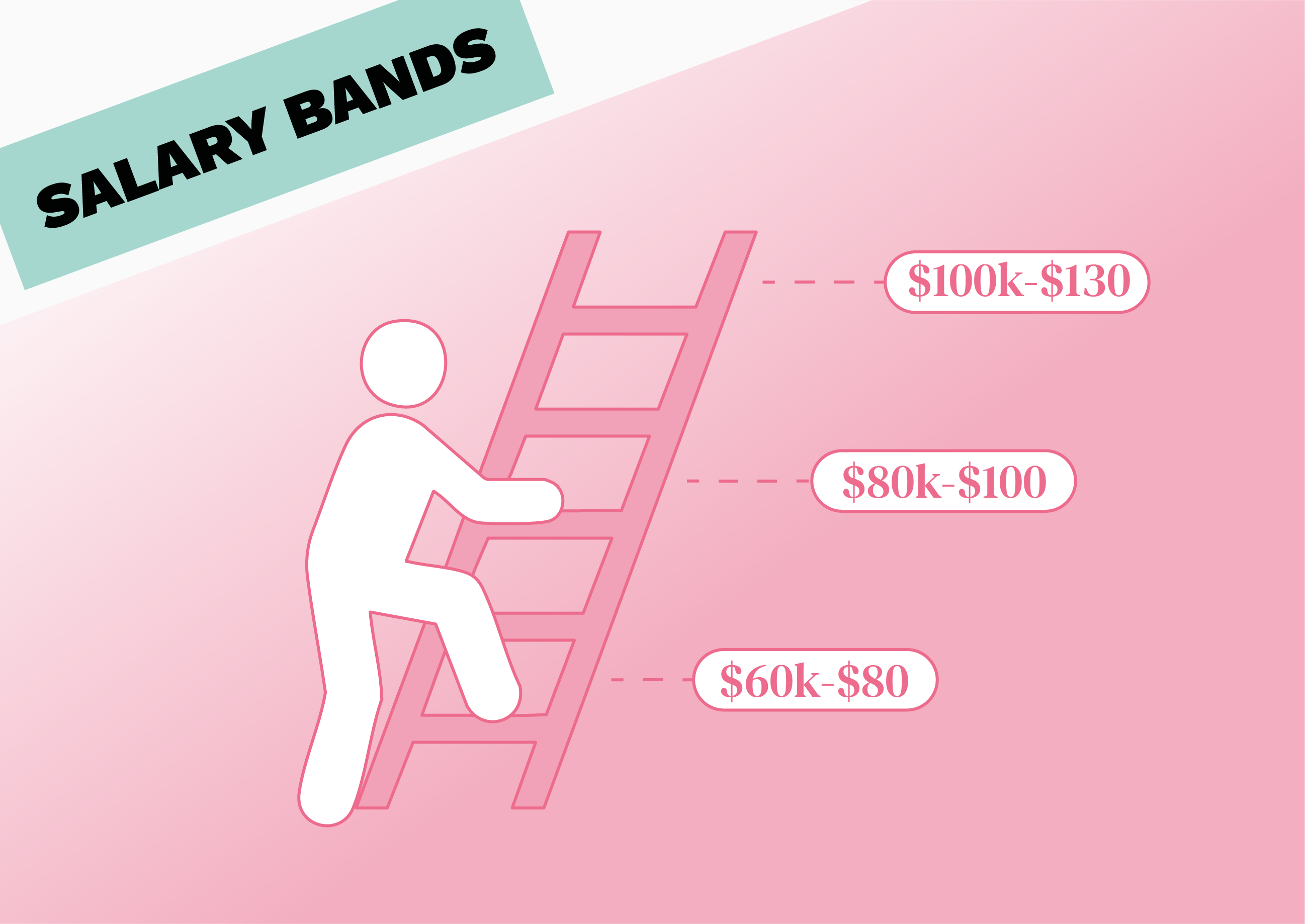HR teams are under a huge amount of pressure. From doing more with less budget, to preparing for the EU Pay Transparency Directive, and trying to attract top talent in a competitive job market. It’s a lot. But sometimes, a fresh way to optimize your compensation practice comes along and just makes everything… easier.
Hello, salary bands.
At Figures, we define these as Ranges of compensation assigned to specific job roles or levels within an organization.
Check out our full explainer for all the details, but in short, the purpose of these bands is to provide the structure, consistency, transparency, and flexibility that define the successful compensation policies of forward-thinking companies.
Sounds great, right? Well, now’s the time to get on board. Here’s everything you need to know about the compensation strategy that has the potential to revolutionize your approach to fairer pay.
Benefits of Salary Bands
Implementing salary bands can seem like a lot of work, but the advantages make a pretty compelling argument for why it’s worth the effort. To prove it, we’ve outlined some of the top benefits right here.
Fairness and consistency
How does your HR team set salaries for new hires? Is it based on subjective decisions from the hiring manager, using historical salary data, or a candidate’s expectations, as a starting point?
If the answer is yes — that’s an extremely inconsistent approach that can easily lead to inequities between the salaries of different employees in the same role.
A better option is to create salary bands for each role in the organization. Because these are based on market data, you know they’re fair and up-to-date. They’re also consistent, meaning HR teams are never put in the awkward position of having to adjust an employee’s salary to compensate for inequities.
Flexibility
It might seem like salary bands create a rigid and inflexible approach to salary negotiations. But set them at the right width and they’re more like guardrails, ensuring there’s a degree of flexibility while also making budget forecasting a whole lot easier.
Because they provide an upper and lower salary limit for each role, salary bands allow for variations in pay based on factors like experience, performance, and market conditions.
Transparency
Employees want to know they’re being paid fairly, but sometimes this information isn’t made available to them. Creating salary bands is a great first step towards equitable pay practices, and openly sharing them is even better.
By providing clarity to employees about the range of compensation they can expect for their role and level, it’s much easier for them to see they’re being paid fairly. And that boosts motivation, trust, and engagement. By formalizing the process of setting salaries, bands also help to reduce bias.
Organizations also need to consider the impact of the upcoming EU Pay Transparency Directive. This will require companies to advertise the salary ranges for each role alongside job descriptions and vacancies.
Proactively preparing for these new regulations by getting your salary bands in place now means that once the directive comes into force — you’re already set.
Cost control
Given that compensation often makes up the largest percentage of an organization’s outgoings, it makes sense to manage these budgets as effectively as possible.
Historically, allowing individual managers to set salaries for their team meant not knowing how much each pay review cycle or new hire is going to end up costing.
By setting salary bands it’s far easier to forecast the maximum allocation for each role, which makes it much easier to plan for the future.
Talent attraction and retention
Sometimes, it can feel like the top talent knows more about what they should be paid than you. That certainly used to be the case when HR teams had to rely on scouring industry reports and salary review sites for details about pay. But these days, there are far better ways to set the right salaries.
The right salary benchmarking tool can be your secret weapon when it comes to developing competitive salaries that maximize your budget — but also attract and retain top talent.
{{cta}}
Considerations for Establishing Salary Bands
The case for establishing salary bands is pretty strong — but what happens next? Being convinced your organization needs salary bands is one thing. Getting them in place is another!
Here are the key factors every organization needs to consider before they dive in:
- Market data: The key to creating accurate salary bands lies in the quality of your data. Having access to a large database of up-to-date salary information for all areas your organization operates in makes it much easier to create accurate salary bands that reflect your organization’s position in the market.
- Organizational goals and culture: What works for a rapidly expanding, remote-first startup operating across multiple countries won’t work for a small legacy business that prioritizes the in-office experience. Getting clear on your organizational goals and culture before creating salary bands makes it much easier to focus on relevant data that aligns with your values, objectives, and budgetary constraints.
- Job roles and levels: Salary bands are a great way to promote career development because they make it easy for employees to visualize what their pay might look like as they progress with your organization. Tailoring salary bands to reflect the hierarchy and diversity of roles means everyone is on the same page and can see what comes next.
- Geographic location: Regional variations make a huge difference to salary expectations. What’s considered a competitive salary in one area might be seen as insufficient somewhere else. That means organizations need to adjust their salary bands to account for geographical differences in the cost of living and market competitiveness.
Implementing and Managing Salary Bands
Already convinced that salary bands are the way forward? Good!
Here are our tips and tricks for how to effectively implement and manage the rollout.
Communicate salary bands with all levels of the organization
Before you set your salary bands, it’s important to communicate the rationale behind why you’re adopting them.
We recommend starting with getting senior leaders on board first. Follow the steps in our Salary Bands Communication Series to gain the backing and support of your leadership team, before moving on to managers and employees.
It’s also important to explain the structure of salary bands, how they’ll be determined (using a solution like Figures’ Salary Benchmarking Tool is your best bet!), and why you’re making the move toward this strategy.
Maintaining full transparency throughout this process means employees don’t feel blindsided, managers feel supported (they’ll be the ones setting salaries and dealing with most employee queries, after all), and leaders understand the positive impact of this initiative.
Train managers and HR professionals
Don’t expect managers and HR professionals to automatically know best practices around the use of salary bands.
Providing training sessions for anyone who will be creating salary bands, or using them within hiring conversations or performance reviews should be offered training and education.
Regularly review and update salary bands
Once your salary bands are set for the first time — you’re not done (sorry). For salary bands to have the best impact, they need to be regularly reviewed and updated.
This ensures alignment with market trends and allows you to make any adjustments depending on the evolving needs of your organization. We recommend reviewing salary bands at least once per year. But it’s even better to aim for biannual reviews.
Address employee questions and concerns
Pay is an emotive issue for employees, and it has the potential to make or break their experience at work. That means any changes to compensation policies need to be addressed compassionately.
Addressing employee concerns and questions about salary bands through clear and open communication channels can make all the difference. This also helps employees feel informed and involved, which boosts trust.
During the first cycle of setting salary bands, you might find some employees need their salaries adjusted if they’re significantly above or below the new bands. Holding sessions with these employees, to explain the impact, can help them understand the process.
It’s also important to inform all employees about the changes. Consider holding town-hall-style sessions where everyone has the opportunity to attend sessions about salary bands and ask questions.
Make sure all employees know who their point of contact is if they have questions or concerns. Whether that’s someone from the HR team or their manager, this step ensures employees who may not want to ask questions in a public forum have the opportunity to raise concerns.
4 Best Practices for Optimizing Salary Bands
You’re nearly set. Before you start optimizing those salary bands, we’ve got four best practice tips to maximize your chances of success.
#1 Set the right range for your salary bands
We recommend using a wide enough range so that you can accommodate variations in each employee’s experience, performance, and skills.
#2 Regular reviews
Salary bands should be reviewed at a minimum once per year, but we recommend biannual reviews. This gives you the best opportunity to adjust bands based on changing market conditions or organizational priorities.
#3 Incorporating performance management
It’s a good idea to incorporate performance-based incentives and bonuses within your salary bands. These show you’re willing to reward and recognize high performers, which can have a big impact on retention and engagement.
#4 Allowing for flexibility
Salary bands are about creating a consistent employee experience around pay, but there should also be room for a little flex. Make sure your bands are wide enough that they can account for factors like employee tenure or outstanding contribution to the organization.
{{cta}}
Take Inspiration From These Success Stories Featuring Figures Existing Clients
Ready to see what the successful implementation of salary bands looks like in real life? We’ve got you.
How Welcome to the Jungle created equitable salary bands, with Figures
When the job search platform Welcome to the Jungle needed to formalize its compensation strategy, creating equitable salary frameworks was high up on the list.
After getting clear on their compensation philosophy (which helps you get clear on market positioning, and how you can apply your company culture to compensation practices) it was time to create the salary bands.
Using Figures’ Salary Benchmarking Tool, the HR team easily developed salary bands for each role and level.
Here’s what the process achieved:
- Talent acquisition and retention: Salary ranges are advertised alongside job openings, helping attract top talent. Once hired, employees can easily visualize what their salary might look like as they progress with the company, boosting loyalty and employee engagement.
- Equitable pay reviews: Salary bands provide the basis for all decisions made during biannual performance reviews. Employees feel reassured they’re all being reviewed using the same consistent, equitable process.
“The solution also helped us to ask ourselves the right questions, step by step. In particular, advice was given on granularity and salary ranges, which was very interesting. I couldn't have done the exercise without it.”
Mathilde Fontaine, People Operations Team Lead at Welcome to the Jungle.
Get Ready to Revolutionize Your Compensation Strategies
Salary bands are one of the most effective ways to optimize your compensation strategies. Whether you’re looking to implement salary bands for the first time, or refine and update your existing bands, Figures can help.
Ready for more compensation insights? Sign up for our newsletter for your monthly compensation shot.
Summarize this article with AI
No time to read it all? Get a clear, structured, and actionable summary in one click.






